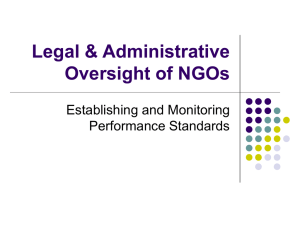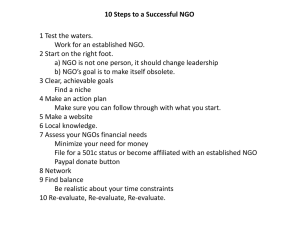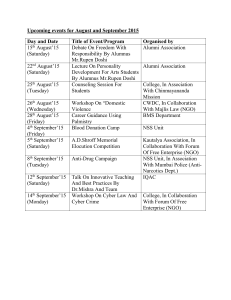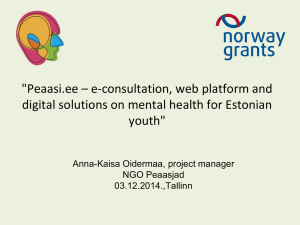Framework Programmes - Programme intervention
advertisement
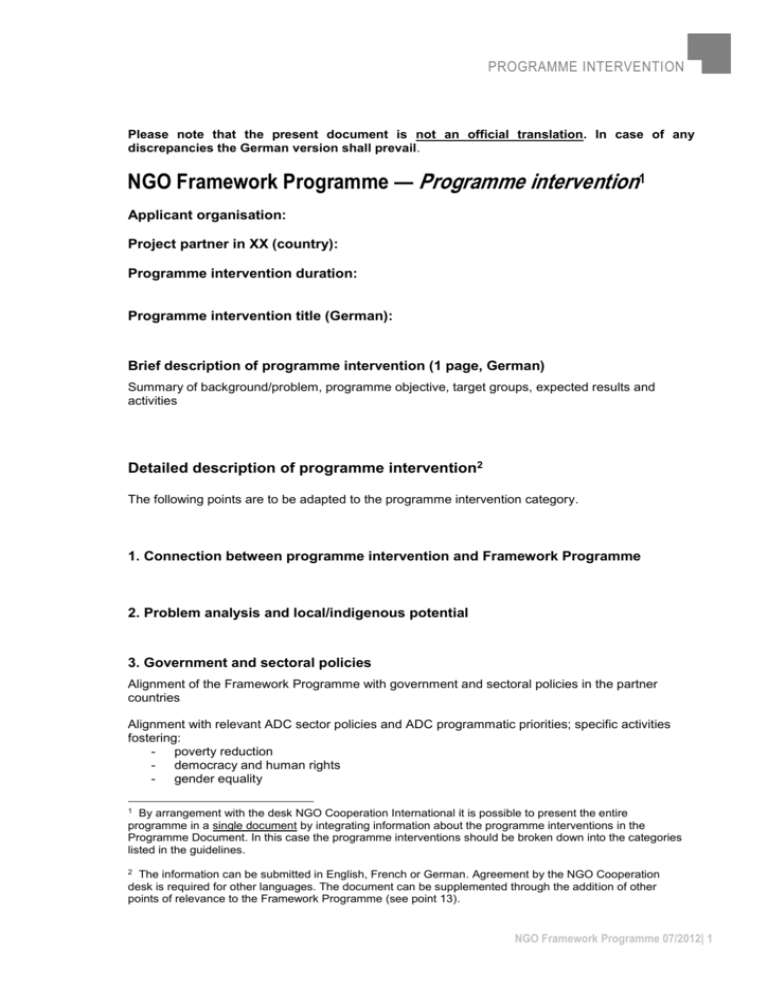
PROGRAMME INTERVENTION Please note that the present document is not an official translation. In case of any discrepancies the German version shall prevail. NGO Framework Programme — Programme intervention1 Applicant organisation: Project partner in XX (country): Programme intervention duration: Programme intervention title (German): Brief description of programme intervention (1 page, German) Summary of background/problem, programme objective, target groups, expected results and activities Detailed description of programme intervention2 The following points are to be adapted to the programme intervention category. 1. Connection between programme intervention and Framework Programme 2. Problem analysis and local/indigenous potential 3. Government and sectoral policies Alignment of the Framework Programme with government and sectoral policies in the partner countries Alignment with relevant ADC sector policies and ADC programmatic priorities; specific activities fostering: - poverty reduction - democracy and human rights - gender equality 1 By arrangement with the desk NGO Cooperation International it is possible to present the entire programme in a single document by integrating information about the programme interventions in the Programme Document. In this case the programme interventions should be broken down into the categories listed in the guidelines. 2 The information can be submitted in English, French or German. Agreement by the NGO Cooperation desk is required for other languages. The document can be supplemented through the addition of other points of relevance to the Framework Programme (see point 13). NGO Framework Programme 07/2012| 1 PROGRAMME INTERVENTION - environmental protection integration of vulnerable groups: o children/adolescents o persons with disabilities (e.g access to education, social services, participation in programmes, empowerment…) o others… 4. Objectives and expected results 5. Target groups, indirect beneficiaries 6. Coordination with relevant actors 7. Activities to implement the focus programme areas of ADC as per ADA Guidelines (Pt. 4.): Capacity Development Exchange of experience and transfer of knowledge between the organizations, the local partners and other relevant actors as well as between local partner organizations Advocacy and policy dialogue on local, regional and national level Support of the development dialogue and the political discourse in partner countries and in Austria Innovative approach and methods Added value of the Framework Programme / Programme Approach 8. Method and activities/programme interventions Programme interventions (by categories in accordance with Funding Guidelines, point 4) 9. Lessons learned in relation to planned activities from earlier programmes/projects 10. Assumptions/risks 11. Sustainability/capacity development 12. Monitoring and evaluation/review NGO Framework Programme 07/2012| 2 PROGRAMME INTERVENTION 13. Other points 12. Planned financing EUR % ADA Applicant Local partners Other third parties (please indicate) TOTAL FINANCING Annexes Annex A: Timetable Annex B: Logical framework/planning matrix Annex C: Gender equality assessment (for Categories I and II) Annex D: Environmental impact assessment (for Categories I and II) Enclosures Programme intervention budgets (Excel file/workbook) NGO Framework Programme 07/2012| 3 ANNEX A) Programme intervention timetable Activities Month or half-year 1 2 3 4 5 … … … … … … … … … … NGO Framework Programme 07/2012| 4 Annex B) Logical framework/planning matrix for programme interventions Reason for intervention Indicators Verification sources Main objective Assumptions/risks No assumptions or risks should be formulated for the main objective Project objective Expected results 1. 2. 3. …. Activities Resources Costs Risks Expected result 1 1.1. 1.2. … Expected result 2 2.1. 2.2. … Expected result 3 3.1. 3.2. NGO Framework Programme 07/2012| 5 Annex C) Questionnaire for assessing the contribution of a project to the equality between women and men (gender-criteria) Title: Organisation: Scoring: The project aims to promote Gender Equality as a principal goal The project aims to promote Gender Equality as a significant goal No goals for promoting Gender Equality have been formulated 2 1 0 Reasons for the scoring: Besides the formulation of goals at least four of the following criteria should be met. The questions ought to be answered accordingly: Preparing the project have there been gender-sensitive consultations? On what level have these consultations been carried out? Who has been consulted? By whom? What are the key findings of the consultations? Developing the project design in what form has gender-sensitive expertise been involved? Is an involvement of a gender-sensitive expert also foreseen for the implementation and for the monitoring? Are gender-sensitive strategies and implementation plans incorporated in the project design? How are they reflected in the activities and the budget? Which gender-sensitive indicators have been developed in relation to the impact of the project activities (short term: for the duration of the project; medium term: for sustainability) How will these indicators be monitored and evaluated? Which barriers for the participation of women have been identified and are there specific measures foreseen to overcome these barriers in the project activities? Which measures are envisaged to make it possible that women and men have equal control over the project results? NGO Framework Programme 07/2012| 6 Annex D) Environmentalal Impact Assessment Questionnaire (for category I and II programme interventions) This questionnaire supplements the project or tender document. Together they form the basis for the Austrian Development Cooperation’s mandatory Environmental Impact Assessment (EIA) for projects within the bilateral programme and project assistance. If an independent EIA report already exists, this can, of course, be enclosed with the project or tender document instead of the completed questionnaire. If the project has been subject (or will still be subject before implementation on the ground) to an EIA within the framework of the national legislation of the partner country, it is not necessary to complete this questionnaire, provided that an appropriate note to this effect is made and appended to the project documentation. If possible, the relevant written report or position of the competent national authority should also be enclosed. If the current project constitutes an extension or a further phase of a particular project, where the goals, strategies and planned activities do not differ substantially from those of the preceding phase, reference to the EIA report and EIA result of the preceding phase is sufficient. Completing the questionnaire will not be necessary. However, any recommendations made in the EIA report of the preceding phase should be taken into account or duly reflected, either in the project or tender document itself or in an appropriate way on a separate sheet of paper. Please write your answers in the space provided immediately below the questions. Where appropriate, reference may be made to information which is already contained in the project or tender document. Explanations to the questions can be found in the supplement entitled "Notes on the Environmental Impact Assessment Questionnaire" 1. Is the project strictly limited to: □ Family planning? □ Food assistance, emergency aid, or refugee aid, or disaster relief (whereas no longer-term infrastructural measures, such as infrastructure for water and energy supply, are planned)? □ The promotion of basic education (whereas no investments for buildings and infrastructure are planned)? □ The promotion of culture? □ The financing of conferences, meetings, workshops, seminars and other training measures, and/or institutional support for the promotion of democracy and human rights/good governance? If yes, please tick the appropriate box. You do not have to answer the other questions. 2. To what extent is the project in line with international, national and regional environmental goals, programmes and priorities, and does it take these into account? (e.g. National Sustainable Development Strategies, National Environmental Action Plans, NGO Framework Programme 07/2012| 7 Action Plans for combating desertification, plans for implementing the Convention on Biological Diversity, etc.) 3. Does the project take into account the environmentally relevant national laws, e.g. concerning the use of natural resources, EIA guidelines, etc.? If so, which ones and how? 4. Was the regional/local environmental situation analysed and the interaction with the social, economic and cultural milieu examined to see whether the pressure on natural resources could indirectly increase? In which way, and how, did the results obtained influence the project conception? 5. Was the project planning undertaken jointly with the partners and the affected population, taking into account their views of the environmental situation and conditions? How does the project reflect these views? 6. To what extent were different approaches and instruments discussed, in order to minimise any potentially negative effects on the environment or to provide for restorative or compensatory measures? 7. Are the project staff, partners and all parties concerned sensitised to environmental problems and the direct and indirect effects on the environment? Are any accompanying measures foreseen in order to promote environmental awareness and knowledge and to enable the project participants to pass on the knowledge they have acquired? 8. a. Is an examination of the environmental effects (and the feedback of the results of such an examination) planned during the implementation of the project? If so, how and when? b. Which indicators were defined for monitoring negative/positive effects? 9. Have the costs for the above-mentioned measures been adequately provided for in the budget plan? NGO Framework Programme 07/2012| 8

